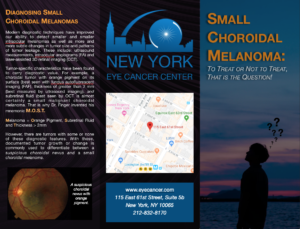One of the most difficult decisions patients and doctors make is when to treat small choroidal melanomas. This is because all treatments carry the risk of affecting visual acuity. This brochure explains most of the risks and potential benefits associated with treating small choroidal melanomas. Also, it describes why eye cancer specialists “watch” suspicious choroidal nevi for change or growth prior to calling them (diagnosing) choroidal melanomas. Most intraocular melanomas are detected during a routine eye examination. That is because they cause no symptoms. This is particularly true for small choroidal melanomas. When small intraocular melanomas are detected, they are measured by ultrasound, evaluated by intraocular angiograms and laser-assisted 3D retinal imaging (OCT). Small choroidal melanomas have much less chance of metastasizing than large tumors. However, all current treatments put the patient at risk for significant vision loss. By watching small tumors for growth, eye cancer specialists will be able to confirm tumor malignancy and proceed to definitive treatment. Dr. Finger’s discusses the risks of observing small melanoma growth compared to initial treatment with each patient. These discussions are based on the tumors size, location, and associated leakage. Only then can the patient understand the relative risks of tumor versus treatment-induced vision loss.
Click the image below to view the brochure »










